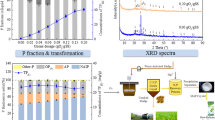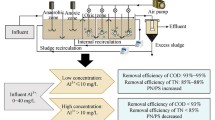Abstract
Most previous studies of phosphorus (P) removal focused on investigation of the soluble, and particulate P, but ignoring the difference between organic and inorganic P. In this study, the effects of various flocculants, namely polyacrylamide (PAM) and polyaluminum chloride (PAC), on flocculation efficiency in different P speciations (organic and inorganic P) were investigated. A modified method to differentiate between organic and inorganic P content in secondary effluent samples was developed. The results showed that P speciation based on organic/inorganic P (Pearson’s correlation R = 0.915, p < 0.05) was more effective than those based on soluble/particulate P (p > 0.05) in evaluating the P content in secondary effluents. The liquid 31P nuclear magnetic resonance measurements results indicated that PAM was more effective in removing organic P (phosphonates and orthophosphate monoesters) rather than inorganic P. However, PAC was more effective in removing inorganic P (particularly orthophosphate) rather than organic P. Based on the modeled results of a response surface methodology (RSM), doses of PAM and PAC were optimized for secondary effluent containing different amounts of organic and inorganic P from the two typical wastewater treatment plants (WWTPs) in Wuhan city, China.








Similar content being viewed by others
Abbreviations
- COD:
-
Chemical oxygen demand
- Mono-P:
-
Orthophosphate monoester
- NMR:
-
Nuclear magnetic resonance
- Ortho-P:
-
Orthophosphate
- PAC:
-
Polyaluminum chloride
- PAM:
-
Polyacrylamide
- Phon-P:
-
Phosphonates
- Poly-P:
-
Polyphosphate
- Pyro-P:
-
Pyrophosphate
- RSM:
-
Response surface methodology
- SS:
-
Suspended solids
- TP:
-
Total phosphorus
- WWTP:
-
Wastewater treatment plant
- X1 :
-
The coded values of the doses of cationic polyacrylamide
- X2 :
-
The coded values of the doses of polyaluminum chloride
References
Aguilar M, Saez J, Lloréns M, Soler A, Ortuno J, Meseguer V, Fuentes A (2005) Improvement of coagulation–flocculation process using anionic polyacrylamide as coagulant aid. Chemosphere 58:47–56
APHA (2005) Standard methods for the examination for water and wastewater, twenty-first ed. American Public Health Association, Washington, D.C.
Arnaldos M, Pagilla K (2010) Effluent dissolved organic nitrogen and dissolved phosphorus removal by enhanced coagulation and microfiltration. Water Res 44:5306–5315
Cade-Menun BJ (2005) Characterizing phosphorus in environmental and agricultural samples by 31P nuclear magnetic resonance spectroscopy. Talanta 66:359–371
Cade-Menun BJ, Navaratnam JA, Walbridge MR (2006) Characterizing dissolved and particulate phosphorus in water with 31P nuclear magnetic resonance spectroscopy. Environ Sci Technol 40:7874–7880
Dueñas JF, Alonso JR, Rey ÀF, Ferrer AS (2003) Characterisation of phosphorous forms in wastewater treatment plants. J Hazard Mater B97:12
EU (2000) Water Framework Directive 2000/60/EC of the European Parliament and of the Council, of 23 October 2000, establishing a framework for community action in the field of water policy. Off J Eur Communities 327:22.12
Fettig J, Ratnaweera HC, Ødegaard H (1990) Simultaneous phosphate precipitation and particle destabilization using aluminium coagulants of different basicity, chemical water and wastewater treatment. Springer:221–242
Fu Y, Wang YZ (2018) An organic-inorganic hybrid coagulant containing Al, Zn and Fe (HOAZF): preparation, efficiency and mechanism of removing organic phosphorus. J Water Reuse Desalin 8:202–213
Guan Q, Zheng H, Zhai J, Zhao C, Zheng X, Tang X, Chen W, Sun Y (2014) Effect of template on structure and properties of cationic polyacrylamide: characterization and mechanism. Ind Eng Chem Res 53:5624–5635
He WX, Sang WJ, Zhang WJ (2017) Design and operation of upgrading project in a wastewater treatment plant in Wuhan. China Water Wastewater 33:67–70 (in Chinese)
Huang R, Tang Y (2015) Speciation dynamics of phosphorus during (hydro) thermal treatments of sewage sludge. Environ Sci Technol 49:14466–14474
Imasuen E, Judd S, Sauvignet P (2004) High-rate clarification of municipal wastewaters: a brief appraisal. J Chem Technol Biotechnol 79:914–917
Jiang J-Q, Graham NJ (1998) Pre-polymerised inorganic coagulants and phosphorus removal by coagulation- a review. Water SA 24:237–244
Kasprzyk M, Gajewska M (2019) Phosphorus removal by application of natural and semi-natural materials for possible recovery according to assumptions of circular economy and closed circuit of P. Sci Total Environ 650:249–256
Langer M, Väänänen J, Boulestreau M, Miehe U, Bourdon C, Lesjean B (2017) Advanced phosphorus removal via coagulation, flocculation and microsieve filtration in tertiary treatment. Water Sci Technol 75:2875–2882
Lee CS, Robinson J, Chong MF (2014) A review on application of flocculants in wastewater treatment. Process Saf Environ Prot 92:489–508
Li R, Zhang Z, Li Y, Teng W, Wang W, Yang T (2015) Transformation of apatite phosphorus and non-apatite inorganic phosphorus during incineration of sewage sludge. Chemosphere 141:57–61
Liu H, Sun L, Wang Y, Xia S, Le L (2009) Application of particle-size analysis in coagulation/flocculation for reclamation of a secondary effluent. Water Sci Technol 60:1455–1463
Liu YY, Zhang WJ, Yang XY, Xiao P, Wang DS, Song Y (2013) Advanced treatment of effluent from municipal WWTP with different metal salt coagulants: contaminants treatability and floc properties. Sep Purif Technol 120:123–128
Liu Y, Wang Y, Sheng H, Dong F, Zou R, Zhao L, Guo H, Zhu X, He B (2014) Quantitative evaluation of lake eutrophication responses under alternative water diversion scenarios: a water quality modeling based statistical analysis approach. Sci Total Environ 468-469:219–227
Liu JL, Li M, Huang H, Liu YR (2017) Engineering design for improved standard in Huangshi municipal wastewater treatment plant. Energ Environ (China):68–73 (in Chinese)
Lu Q, He ZL, Graetz DA, Stoffella PJ, Yang X (2010) Phytoremediation to remove nutrients and improve eutrophic stormwaters using water lettuce (Pistia stratiotes L.). Environ Sci Pollut Res 17:84–96
Murphy J, Riley JP (1962) A modified single solution method for the determination of phosphate in natural waters. Anal Chim Acta 27:31–36
Nguyen DD, Ngo HH, Guo W, Nguyen TT, Chang SW, Jang A, Yoon YS (2016) Can electrocoagulation process be an appropriate technology for phosphorus removal from municipal wastewater? Sci Total Environ 563-564:549–556
Ni Z, Wang S, Wang Y (2016) Characteristics of bioavailable organic phosphorus in sediment and its contribution to lake eutrophication in China. Environ Pollut 219:537–544
Park T, Ampunan V, Lee S, Chung E (2016) Chemical behavior of different species of phosphorus in coagulation. Chemosphere 144:2264–2269
Qiu G, Song Y, Zeng P, Xiao S, Duan L (2011) Phosphorus recovery from fosfomycin pharmaceutical wastewater by wet air oxidation and phosphate crystallization. Chemosphere 84:241–246
Read EK, Ivancic M, Hanson P, Cade-Menun BJ, McMahon KD (2014) Phosphorus speciation in a eutrophic lake by 31P NMR spectroscopy. Water Res 62:229–240
Remy C, Miehe U, Lesjean B, Bartholomaus C (2014) Comparing environmental impacts of tertiary wastewater treatment technologies for advanced phosphorus removal and disinfection with life cycle assessment. Water Sci Technol 69:1742–1750
Venkatesan AK, Gan W, Ashani H, Herckes P, Westerhoff P (2018) Size exclusion chromatography with online ICP-MS enables molecular weight fractionation of dissolved phosphorus species in water samples. Water Res 133:264–271
Villaseñor Camacho J, Fernández Marchante CM, Rodríguez Romero L (2018) Analysis of a photobioreactor scaling up for tertiary wastewater treatment: denitrification, phosphorus removal, and microalgae production. Environ Sci Pollut Res 25:29279–29286
Wang Y, Han T, Xu Z, Bao G, Zhu T (2005) Optimization of phosphorus removal from secondary effluent using simplex method in Tianjin, China. J Hazard Mater 121:183–186
Wang JP, Chen YZ, Wang Y, Yuan SJ, Yu HQ (2011) Optimization of the coagulation-flocculation process for pulp mill wastewater treatment using a combination of uniform design and response surface methodology. Water Res 45:5633–5640
Wang S, Liang P, Wu Z, Su F, Yuan L, Sun Y, Wu Q, Huang X (2015) Mixed sulfur–iron particles packed reactor for simultaneous advanced removal of nitrogen and phosphorus from secondary effluent. Environ Sci Pollut Res 22:415–424
Worsfold PJ, Monbet P, Tappin AD, Fitzsimons MF, Stiles DA, McKelvie ID (2008) Characterisation and quantification of organic phosphorus and organic nitrogen components in aquatic systems: a review. Anal Chim Acta 624:37–58
Xie C, Zhao J, Tang J, Xu J, Lin X, Xu X (2011) The phosphorus fractions and alkaline phosphatase activities in sludge. Bioresour Technol 102:2455–2461
Zhao YX, Gao BY, Shon HK, Cao BC, Kim JH (2011) Coagulation characteristics of titanium (Ti) salt coagulant compared with aluminum (Al) and iron (Fe) salts. J Hazard Mater 185:1536–1542
Acknowledgments
The authors would like to thank the Analytical and Testing Center of Huazhong University of Science and Technology for providing experimental measurements. The authors also thank Mr. Zirong Yang for his help in sampling waste activated sludge from the wastewater treatment plants.
Funding
The research was supported by the National Key Research and Development Program of China (2018YFD1100604) and the National Natural Science Foundation of China (51708239).
Author information
Authors and Affiliations
Corresponding authors
Additional information
Responsible editor: Bingcai Pan
Publisher’s note
Springer Nature remains neutral with regard to jurisdictional claims in published maps and institutional affiliations.
Electronic supplementary material
ESM 1
(DOCX 6399 kb)
Rights and permissions
About this article
Cite this article
Xu, Q., Xiao, K., Wang, H. et al. Insight into effects of organic and inorganic phosphorus speciations on phosphorus removal efficiency in secondary effluent. Environ Sci Pollut Res 27, 11736–11748 (2020). https://doi.org/10.1007/s11356-020-07774-9
Received:
Accepted:
Published:
Issue Date:
DOI: https://doi.org/10.1007/s11356-020-07774-9




